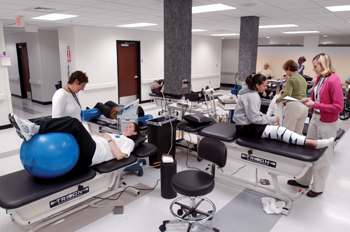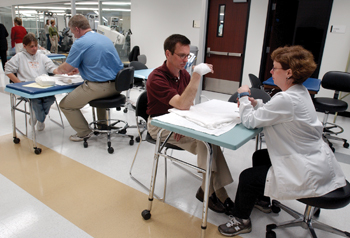
Julie Neaderthal, a physical therapist, left, works with patient Angela Steelywhile patient Marie Montgomery sees physical therapist Emily Preston, right, in the new orthopaedic therapy area. Monday was the first day for patients to be seen in the new area, located in Medical Center East South Tower.
photo by Dana Johnson
Orthopaedics opens new home

Peggy Haase, occupational therapist and certified hand therapist, works with patient Chuck Owen on hand exercises on the first day in the new Orthopaedic Institute located in the South Tower.
photo by Dana Johnson
The new Vanderbilt Orthopaedic Institute (VOI) opened its doors to patients this week in its new Medical Center East South Tower location. The move brings together all of the Orthopaedic clinics, which will occupy the third and fourth floors of the building.
“There’s no question this gives us the leverage to become one of the premier Orthopaedic programs in the country,” said Dan Spengler, M.D., professor and chairman of the Department of Orthopaedics and Rehabilitation. “It will allow us to go from good to great. When you have facilities like this, you can recruit and retain the top people in the field.”
Previously spread out all over the Medical Center campus, the Hand Center, Sports Medicine Center, Spine Center, Oncology, Total Joint Replacement, Orthopaedic Trauma, Adult Physical and Occupational Therapy will fill the 90,000 square foot location, along with a state-of-the-art fitness center.
“There are many niche specialty institutions, but to put all these niches together into a comprehensive program is something unique,” Spengler said.
The VOI has 54 exam rooms, large waiting rooms, and digital imaging services, physical therapy and fitness facilities on-site. The physician, staff and administrative offices are also located in the space.
“This is a huge positive for our patients – to truly have one stop shopping,” said Kurt Spindler, M.D., professor of Orthopaedics and Rehabilitation and director of the division of Sports Medicine. “We’re not a group of general orthopaedic physicians; we’re a group of sub-specialists, who are highly skilled in our areas. We transfer patients back and forth so the most skilled physician is working on their specific need, and this facility will make it much easier for both the patients and for us to do this.”
The 10,000 square-foot fitness center housed on the third floor includes a 1/12 mile track, cardio and strength equipment, exercise studios, locker facilities, and a hydrotherapy tank. The cardio equipment has integrated LCD TV screens in each unit, along with a custom, state-of-the-art computerized exercise system that will act as a virtual personal trainer. The center will be open to community membership, as well as available for patients.
“It’s truly a unique model for overall fitness — someone can work through a debilitating injury or maintain an active lifestyle in one building,” Spindler said. “We’ll have physicians, physical therapists, personal trainers and athletic trainers all in the same area, to bring someone through their injury to a state of prevention for the future.”
Having experience tremendous growth over the past 10 years, the Department of Orthopaedics and Rehabilitation’s clinics had spilled over into any space that was available across campus. Spengler said the growth coincided with the expansion of the field and the increasing patient demand for services.
“People’s expectations are very different today,” he said. “In the past, if you gave an older person a cane, they were happy to limp along. Today, we have 80-year-olds breaking down our doors to get back to their golf game.
“We’ll keep growing and keep working to enhance the quality of life for our patients.”













